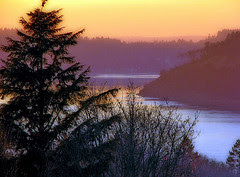Now Mount St. Helens smolders only two hours from my own back door. The site has been turned into a National Volcanic Monument, complete with visitor centers, hiking trails, and cheesy, kid-friendly theme parks. After a night of camping in nearby lush, green Seaquest State Park, Z and I headed towards the west flank of the mountain to visit this rapidly changing landscape. Here are a few highlights of the trip:

Even on clear days, the top of Mount St. Helens (upper left-hand corner) is often covered by a thin layer of clouds. We went hiking along the north-western edge of the volcano, mostly along a ridge above the primary blast zone. The mountain blew out its northern side, and below the cloud layer you can see the crater. There are currently two lava domes that are growing within it at a rate of a few inches every day. Below the mountain you see the wasted valley. There were once lush evergreen forests here, but now the land is scarred by the lava flow and very little grows in it.

This picture was taken with Mount St. Helens at our back, looking northward in the direction of the blast. These hills, once covered with forest, are now littered with the torsos of trees blown off their trunks. It's a little difficult to see, but the trees still rest where they fell, all in the same direction.

The destination of our 6-mile hike was Spirit Lake, seen here. Spirit Lake has rested at the northern edge of Mount St. Helens for thousands of years, created by another eruption. Until 1980 it was the site of several homes and a resort community. One particular resident, Harry Truman, became a national icon for refusing to leave his home of 50 years in the weeks leading up to the eruption. He didn't believe that the eruption could possible affect his home, lying only five miles from the base of the mountain. As it was Spirit Lake not lay directly in the path of the blast, but it was also instantly buried under a mountain of lava. Harry Truman most certainly died instantly (his body or his home were never recovered.) You can't see it, but trees still lay strewn along the shores of the lake. Mount Adams is visible in the upper right hand corner.

We took this final shot as we were driving away around 6:30 PM. The clouds were finally parting from the crater, and the moon had risen. Look carefully and you can see a small plume of smoke that still rises from this still-active volcano.





No comments:
Post a Comment